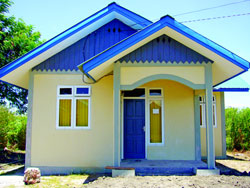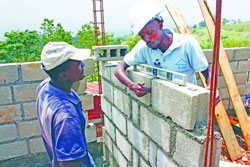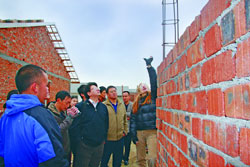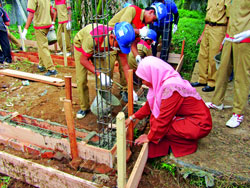TECHNOCRATE
'BUILD CHANGE' - Builds a Better Future in Seismic Zones
|
According to the US Geological Survey estimation, several million earthquakes occur in the world each year. Many go undetected because they hit isolated areas or have very small magnitudes. The National Earthquake Information Center (NEIC) now locates about 50 earthquakes each day, or about 20,000 a year. Majority of the causalities are from the seismic prone areas of Japan, Indonesia, New Zealand, Mexico and parts of US & China.
|
 |
In many ways, Japan is still reeling from the devastating earthquake which killed about 16,000 people 4,647 still missing, 130,927 displaced and at least 332,395 buildings, 2,126 roads, 56 bridges and 26 railways destroyed or damaged by the earthquake and tsunami leaving many homeless.
Other countries in Asia-Pacific zone, parts of Europe fall under high risk seismic alert zones. As per National Disaster Management Authority of India, earthquake is a major issue of concern as over 58.6 per cent of land in India is highly vulnerable to earthquakes and 38 cities fall under moderate to high risk seismic zones.
|
After each major disaster a Nation will be pushed into lot of soul searching as it will be worn down by economic growth and political crisis, leading to the need of international help. The road to recovery will be a long one, as tons of debris has to be removed and a new beginning to be initiated to rebuild the area. In what international officials term a long-drawn-out humanitarian crisis, many remain in increasingly desolate tent camps. Thousands of inhabitants reside in dangerously damaged buildings. And countless others were evicted from camps and yards were also disappeared.
|
 |
To avoid these ghastly incidents, civil and structural engineers should try to implement economically viable construction practice considering all structural components which can be clearly understood with the concept of Earthquake Resistance houses. These structures should be more ductile in nature.
From the past analysis of seismic incidence, engineers and architects agree with the fact that meticulous planning at the foundation stage of a building can reduce the casualties to considerable number and sometimes even minimal. But on the other hand, they are apprehensive about budget allocation to build such houses as the support from the government is minimal and also there is lack of political will to implement changes.
To break this myth and create awareness about earthquake resistant houses, 'Build Change', an International non-profit social enterprise is working towards this concept since 2004. The organization has ventured into an enormous task of designing earthquake resistant houses in developing countries. They are also training and creating awareness among the locals, builders, homeowners, engineers and government officials to build seismic resistant structures. The Build Change teams facilitate these training programs which stimulates local demand for safe and affordable building using local materials. The team's mission is to significantly reduce death, injuries and economic losses during an event of an earthquake.
Build Change uses and promotes a homeowner-driven model - a model that creates permanent change in construction practices. This model has begun to receive notice and even sought out by several large disaster relief organizations. When homeowners drive the process and make their own decisions about design and materials, the cost of building the house can be as much as three- to four-times less than a donor-built house.
|
Dr. Elizabeth A Hausler Strand, the founder and the CEO of the organization Build Change, created an innovative, sustainable, highly replicable model around the theory of change and this lead to the formation of non-profit social enterprise Build Change. It started functioning in Aceh, Indonesia, after a powerful earthquake in 2004, and began testing its theory of change. The organization found that its theory of change worked and since then, has refined and transferred this model to West Sumatra - Indonesia; Sichuan - China; and Port-au-Prince - Haiti, during post-disaster situations.
|
 |
Dr. Hausler received the 2011 Lemelson-MIT Award for Sustainability for designing disaster resistant building in China, Haiti and Indonesia. Schwab Foundation named her as a 2011 US Social Entrepreneur of the year. She was a panelist at the 2010 Annual Meeting of the Clinton Global Initiative, and a member of the 2007 cohort of the Global Social Benefit Incubator Program at Santa Clara University. She holds an MS and Ph.D in Civil Engineering from the University of California, Berkeley and an MS in Environmental Science from the University of Colorado. She has delivered lectures on sustainable, disaster resistant construction worldwide. She served on the 2002-2003 US National Research Council Committee to develop a long term research agenda for Earthquake Engineering.
|
The idea of building Earthquake Resistant house is considered as a unique and sustainable concept. Talking about her inspiration to initiate Build Change Dr. Hausler says, "In 2002, I had been to Gujarat - India, on a Fulbright fellowship to study and assist with post-reconstruction efforts after a devastating earthquake which killed more than 20,000 people. I learnt that after a major earthquake in a developing country, agencies typically build houses en masse that is not always culturally appropriate and sustainable in the local construction sector. Often, the homeowner is only minimally involved in the decision-making and construction process. The opportunity to build local capacity is often missed, and in many cases, the houses built after the funding and technical assistance cease are not earthquake-resistant."
|
 |
|
After observing these efforts, Dr. Hausler developed a theory of change. She feels that earthquake-resistant construction in developing countries will become common only if the right technology is locally available, widely known and culturally accepted. In addition, the cost of the technology must be competitive with existing, but not necessarily safe, building methods.
|
 |
Build Change's model is considered as sustainable because the organization applies the following principles and strategies.
-
Local Solutions. Use detailed housing subsector studies to determine the most cost-effective ways of building earthquake-resistant houses using materials and skills that are available through the local private sector.
-
Technical Excellence. Leverage the knowledge and skills of the best engineers and architects in the world - both in the U.S. and the developing world - to ensure that the very best designs and design thinking are applied to the reconstruction efforts while sticking to a carefully compiled list of criteria for local sustainability and acceptance.
-
Equality. Empower the homeowners to choose their own layout and materials and manage their own construction with Build Change's technical assistance, by providing a range of solutions appropriate for different income levels, family size, culture and climate.
-
Job Creation. Work with local masons, carpenters and homeowners to incorporate disaster-resistant building techniques that are culturally accepted and easy to adopt with limited training and education.
-
Local Capacity. Build local capacity by hiring and working with local engineers, architects, builders, universities and governments and training technical high school students.
-
Economic Growth. Kick start the local economy by purchasing locally available materials and products.
-
Bridging the Gap. Learn and spread best practices from post-disaster housing reconstruction programs so that the many other agencies involved in these efforts build better houses and leave in place more sustainable local impacts.
Dr. Hausler agrees with the fact that buildings can sustain earthquake with the correct usage of quality materials. She explains, "The correct use of good quality materials is very important for good performance of buildings during earthquakes. Confined masonry is a type of construction common in India, other parts of Asia, and Latin America for low-rise, simple buildings. It combines brick, block or stone masonry load-bearing wall with reinforced concrete confining elements which tie the walls together. If built properly according to the three C's i.e., Configuration, Connections and Construction Quality, confined masonry buildings can perform well in earthquakes. If built incorrectly, these buildings can be deadly in earthquakes. Build Change is a founding member of the Confined Masonry Network; the first meeting was held at IIT-Kanpur in January 2008."
When asked about the benefits and changes the society can foresee with the arrival of this concept Dr. Hausler proudly asserts, "We have already beginning to see a shift in the way disaster relief agencies think about post-disaster reconstruction services. For years, relief agencies have been using a donor-driven model after major earthquakes in developing countries - a model that does not include, or minimally includes, the homeowner. This approach does not create sustainable change in construction practices as houses built after the funding and technical assistance cease most often are not earthquake-resistant."
She adds, "If even a few relief agencies adopted the more sustainable, homeowner-centric approach, it could be the "tipping point" to changing post-earthquake reconstruction programs globally, which would create permanent change in construction practices in developing countries - to ones that are safe, earthquake-resistant and widely accepted by local communities - greatly reducing deaths, injuries and economic losses caused by housing collapses due to earthquakes."
The organization has spread its wings to Indonesia, Haiti and China. The organization claims that the response in all of these countries has been extremely positive from all parties involved in the reconstruction process.
-
West Sumatra, Indonesia. After training education supervisors in West Sumatra, the chief of the Provincial Education Bureau declared that the Bureau was in the process of incorporating Build Change's ERDC training into the schools' curriculum. In addition, a reconnaissance study after the September 2009 earthquake in West Sumatra found that none of the 655 houses built to our minimum earthquake-resistant standards following the area's September 2007 earthquake had suffered any damage (although other structures in the area had collapsed). After that 2009 earthquake, a number of homeowners started rebuilding using the techniques we had previously introduced.
-
Sichuan, China. After providing hands-on training to the Chinese township government and devising simple, easy-to-use building standards, the township government asked Build Change to assist with inspections - a significant step toward building reinforcement in rural China. The national government also asked Build Change to expand the training throughout Sichuan and other regions in China.
-
Port-au-Prince, Haiti. The Haitian Ministry of Public Works (MTPTC) is partnering with Build Change to develop a Haiti-wide retrofit guideline. Once these guidelines are published and officials are trained, they will be used and enforced throughout the country even after reconstruction efforts are complete-impacting tens of thousands more buildings and lives.
Build Change has designed earthquake-resistant design and construction (ERDC) training programs for engineers, builders, homeowners, technical students, vocational school teachers and education supervisors to introduce them to the basics of ERDC principles and techniques. The training includes a combination of classroom seminars, practical exercises and demonstrations on how to read a drawing, estimate quantities, choose good quality materials and design and build safe houses.
She also believes that the training course provides an excellent introduction to ERDC, it is most effective when builders also have onsite supervision and mentoring during construction to ensure proper application of the techniques they learned. Build Change thus, provides construction site supervision, inspecting each stage of the construction process against a checklist that verifies that construction meets the minimum standards for earthquake safety.
Dr. Hausler strongly feels that, building an earthquake-resistant house can have a positive effect on the environment because the lifespan of the building is longer, thereby reducing consumption of resources. She elucidates, "Earthquake-resistant buildings will not collapse in an earthquake and will not need to be rebuilt. Also, many homeowners Build Change works with in Indonesia, choose to build their houses from locally grown or reused timber, which has a lesser environmental imprint and can be more earthquake-resistant than homes made of bricks and concrete."
Recalling her visit to India, Dr. Hausler says, "From 2002 to 2004, I visited the areas affected by the 1993 Maharashtra / Killari earthquake, the 1999 Chamoli earthquake, and the 2001 Bhuj / Gujarat earthquake. At that time, the Indian sector was leading the world in the most sustainable, safe and satisfactory approach to post-earthquake housing reconstruction, as evidenced in the Bhuj reconstruction. The Indian government was using a homeowner-driven approach, which was a significant source of inspiration for Build Change's work."
Suggesting few guidelines for India where many parts are categorized under seismic zones Dr. Hausler says, "For high-rise and other buildings built through the formal sector, following the Indian building codes is essential. Everyone has a role to play in building safely - planners, engineers, architects, owners, government officials, contractors, builders and building materials producers. There are some excellent resources and training courses offered by the NICEE, Kanpur. The Earthquake Tip Sheets produced by National Information Centre of Earthquake Engineering (NICEE) IIT-Kanpur are very informative and user-friendly. They have received global recognition and have been translated into multiple languages, including French, to support our work in Haiti. For buildings built in the informal sector, referring to the tip sheets and other resources available in India, such as the simple guidelines produced to support the reconstruction following the 2001 earthquake near Bhuj, is the best way to promote safe construction. Hands-on builder training is necessary for change to take place."
She continues to say, "At the moment, Build Change does not have plans to work in India, however, we look forward to continuing to learn from the successes in the Indian sector."
|
When asked about how affordable the earthquake resistant building for developing and under-developed countries, Dr. Hausler says, "Build Change looks for low- or no-cost improvements to existing ways of building houses. During the process, we make sure we identify materials that are available locally and building techniques that are culturally accepted and easy to adopt with limited training and education. By introducing incremental changes to existing practices, especially in areas where the most common defects occur, change in construction practices is more likely to be adopted and sustained over time."
|
 |
Citing an example, she explains, "A no-cost improvement that increases wall strength substantially in Indonesia includes soaking bricks in water to increase the bond between bricks and mortar, and walls in China with lots of openings can be strengthened by placing lintel beams over the openings and not locating them next to corners."
She adds, "In Indonesia, new houses built through homeowner-driven technical assistance programs generally cost anywhere from US$3,000 to US$17,000 less than similar structures built in donor- or contractor-driven environments. In Haiti, retrofits can cost anywhere from $1,500 to $3,500, with a per square meter cost ranging from $40 to $100."
Build Change partners with:
-
Local, state and national governments to develop building code standards, simple enforcement systems, and homeowner financing.
-
Large relief agencies - CARE, Catholic Relief Services, Mercy Corps, Cordaid, CHF International, Oxfam, Save the Children, and the Red Cross – to train their staff to reach more homeowners and builders with earthquake-safe housing solutions and provide financing.
-
Vocational schools and education bureaus to incorporate ERDC as a part of the school curriculum and build a pipeline of builders trained in ERDC.
-
Private sector (local building materials producers and suppliers) to distribute information on safe reconstruction and provide quality products.
-
Financial institutions to facilitate homeowners' access to financing so they can build back safely.
-
The best engineers and architects in the world to ensure the highest-quality designs and design thinking are applied to reconstruction, while maintaining the criteria for local sustainability and acceptance.
To implement their ideas, Build Change expects to partner with local governments and the authorities on helping enforce the reconstruction model as a new building standard, reducing community resistance to change and leading to further implementation. In addition, Build Change expects to partner with local governments to develop simple, practical design guidelines and enforcement systems for building and inspecting safe houses, and create a streamlined, simple inspection and monitoring system for enforcing those standards.
Build Change signed a Memorandum of Agreement with Haiti's Ministry of Public Works, (MTPTC) to provide technical assistance and training services to the Government of Haiti. In addition, the organization has also been working with the MTPTC to develop a Haiti-wide retrofit guideline, which will be published by the MTPTC soon, to help ensure this solution can scale to meet the much greater need in Haiti. In Indonesia, the education bureau in West Sumatra is partnering with us to incorporate ERDC into the school district's curriculum. In China, we worked with government officials to develop inspection guidelines and expand training throughout Sichuan.
In order to create awareness around the world, Dr. Hausler speaks regularly at global conferences on such topics as sustainable disaster-resistant construction and social entrepreneurship. She also participates on various panels to inform the discussion about how a homeowner-driven model in post-disaster reconstruction efforts can bring about permanent change in construction practices.
Dr. Hausler strongly opines, "Earthquakes don't kill people, poorly built buildings do. This is a man-made problem with a man-made solution. It is possible to build simple, safe, sustainable earthquake-resistant buildings, including homes for low-income homeowners."
While building techniques and materials used vary by location, to ensure successful implementation and sustainability, Build Change has identified the following three critical factors, or "The Three C's," for durable, culturally acceptable and affordable reconstruction:
Configuration
Applying careful thought to a home's design plan and layout can improve its resistance to earthquakes at little or no extra cost. For example, ensuring that structural walls are symmetrical and that there are approximately the same number of load-bearing walls in each direction per home will help improve its durability during natural disaster.
Connections
Unreinforced or unconfined masonry walls fail in earthquakes. Making strong "connections" between all components of the home (e.g., all walls, the foundation and the confining elements) is necessary for structural integrity. Connecting the roof to the walls especially is essential for safety in both earthquakes and hurricanes.
Construction Quality
Using quality materials and workmanship is the first line of defense for an earthquake-resistant home. Simple, inexpensive techniques, like soaking bricks in water prior to building a masonry wall, make all the difference in the resilience of a house. Using locally available resources and labor also help make this the most affordable and culturally acceptable reconstruction process.